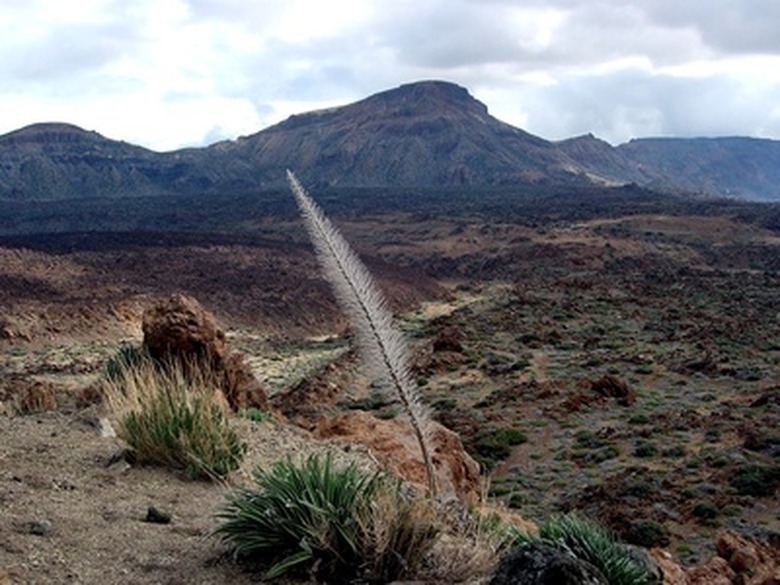The Best Trees To Plant In West Texas
West Texas is a high desert climate of subfreezing winters and hot summers. At elevations between 3,000 and 4,500 feet, only 12 inches of rain occurs annually, most in midsummer. This region, which includes cites like Amarillo, Lubbock, Odessa and El Paso begs for tough, durable trees to provide shade and shelter from winds.
Large Trees
If you seek large shade trees, those growing taller than 40 feet in mature height, several options exist. Rustic landscapes wouldn't seem complete without an oak. Try chinkapin oak (Quercus muehlenbergia) or the live oak (Quercus virginiana) sans the drooping Spanish moss. Anaqua (Ehretia anacua) and Chinese parasol (Firmiana simplex) make sound choices, but fast-growing shade comes from the Arizona ash (Fraxinus velutina), sweetgum (Liquidambar styraciflua) and fruitless mulberry (Morus alba).
- West Texas is a high desert climate of subfreezing winters and hot summers.
- This region, which includes cites like Amarillo, Lubbock, Odessa and El Paso begs for tough, durable trees to provide shade and shelter from winds.
Small Trees
Trees that lose their foliage in winter and mature to heights at or less than 40 feet work well in the typical scale of residential and farm buildings. Texas red oak (Quercus texana) may grow larger, but without irrigation and pampering remains smaller. Other choices include mesquite (Prosopis glandulosa), manzanilla olive (Olea manzanilla), Mexican persimmon (Diospyros texana), western soapberry (Sapindus drommondii) and nutleaf hackberry (Celtis reticulata). Excellent red fall foliage displays occur on the Chinese pistachio (Pistacia chinensis).
Flowering Ornamental Trees
Consider adding small trees that not only shade and create an intimate garden oasis, choose some that provide seasonal floral beauty as well. Fragrant white blossoms occur on the Mexican plum (Prunus mexicana) while Texas mountain laurel (Sophora secundiflora) remains evergreen with fragrant flowers. Wispy foliage and cheerful yellow flowers adorn Jerusalem thorn (Parkinsonia aculeata) in late spring. Additional trees include desert willow (Chilopsis linearis) and the panicle golden raintree (Koelreuteria paniculata). Chaste tree (Vitex agnus-castus) bears summertime purple-blue flowers for butterflies and bees. Consider callery pears (Pyrus calleryana) but avoid variety 'Bradford' since it tends to crack and shed branches when only 15 to 20 years old.
- Trees that lose their foliage in winter and mature to heights at or less than 40 feet work well in the typical scale of residential and farm buildings.
- Fragrant white blossoms occur on the Mexican plum (Prunus mexicana) while Texas mountain laurel (Sophora secundiflora) remains evergreen with fragrant flowers.
Edible or decorative fruits linger on crab apples (Malus spp.), peaches (Prunus persica), and possomhaw (Ilex decidua), the former two bearing noticeable ornamental blossoms. Most people want thornless Osage oranges (Maclura pomifera), and its large round fruits are either thought of as decorative or messy lawn litter.
Conifer Evergreens
Needle or scale-foliage trees that produce cones provide year -round screening, shade or block winds. Aleppo pine (PInus halepensis) doesn't grow nearly as large as the ponderosa pine (Pinus ponderosa). The mountain cedar (Juniperus ashei) and Arizona cypress (Cupressus arizonica) make excellent hedgerows or screens.
Palms
In the more southern reaches of West Texas, dally in the tropical exotic look by planting palms in clusters or singularly as a focal specimen. Canary Island date palm (Phoenix canariensis) and the true date palm (Phoenix dactylifera) grow, but don't expect fruits if the summer heat doesn't last long. Mexican fan palm (Washingtonia filifera) bears persistent dead fronds in a beige, dry petticoat while the California fan palm (Washingtonia robusta) grows taller and tends to be less hardy to winter cold.
- Edible or decorative fruits linger on crab apples (Malus spp.
- ), Mexican fan palm (Washingtonia filifera) bears persistent dead fronds in a beige, dry petticoat while the California fan palm (Washingtonia robusta) grows taller and tends to be less hardy to winter cold.
References
- Texas A&M University: Texas Recommended Trees
- "Sunset National Garden Book"; Editor Kathleen N. Brenzel; 1997
